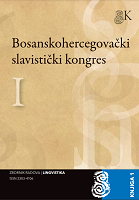Restandardizacijski procesi u bosanskom, crnogorskom, hrvatskom i srpskom jeziku
The Processes of Re-standardization in Bosnian, Montenegrin, Croatian and Serbian
Author(s): Rajka GlušicaSubject(s): Morphology, Historical Linguistics, Sociolinguistics, South Slavic Languages
Published by: Slavistički komitet BiH
Keywords: re-standardization; standardization; variantion; communicative and symbolic functions of a language;
Summary/Abstract: The paper discusses the theoretical framework that could accommodated in the best way in the current standardization processes in the newly-standardized South Slavic languages in the historical, socio-political and sociolinguistic situation after the collapse of Yugoslavia and the extinction of its official language – Serbo-Croatian. South Slavic language theorists, among others, attempted to construct theoretical models of language planning which may include procedures in languages that, after Serbo-Croatian standard, entered the process of building their own languages. When we talk about the stages in the planning and development for standardized language in which a change of status, we have to point out that all standard languages derive from the standard Serbo – novostokavian. This resulted in the fact that the theoretical linguistics started to talk about the process of reshaping and re-standardization, but on somewhat different grounds. In doing so there should be made a systematic difference between the two conceptually different formats, one based on dialect and the other from the already existing standard language base, where two or more standard varieties of language are built from a common standard, as is the case with the new standard languages arising from the polycentric Serbian language. Therefore, the proposed scheme of the process that leads to a transformation consisting of: 1. standardization; 2. variantion, 3. re-standardization is fully applicable to our linguistic reality. After the theoretical part of the paper, the author has offered the re-standardizational comparison procedures as well as their results in four (new) standard language to see to what extent are divergent processes including ongoing.
Journal: Bosanskohercegovački slavistički kongres
- Issue Year: I/2012
- Issue No: 1
- Page Range: 25-34
- Page Count: 10
- Language: Montenegrine

